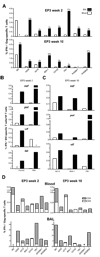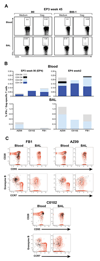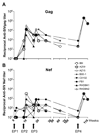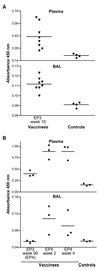Long-lasting humoral and cellular immune responses and mucosal dissemination after intramuscular DNA immunization
- PMID: 20451642
- PMCID: PMC2932451
- DOI: 10.1016/j.vaccine.2010.04.064
Long-lasting humoral and cellular immune responses and mucosal dissemination after intramuscular DNA immunization
Abstract
Naïve Indian rhesus macaques were immunized with a mixture of optimized plasmid DNAs expressing several SIV antigens using in vivo electroporation via the intramuscular route. The animals were monitored for the development of SIV-specific systemic (blood) and mucosal (bronchoalveolar lavage) cellular and humoral immune responses. The immune responses were of great magnitude, broad (Gag, Pol, Nef, Tat and Vif), long-lasting (up to 90 weeks post third vaccination) and were boosted with each subsequent immunization, even after an extended 90-week rest period. The SIV-specific cellular immune responses were consistently more abundant in bronchoalveolar lavage (BAL) than in blood, and were characterized as predominantly effector memory CD4(+) and CD8(+) T cells in BAL and as both central and effector memory T cells in blood. SIV-specific T cells containing Granzyme B were readily detected in both blood and BAL, suggesting the presence of effector cells with cytolytic potential. DNA vaccination also elicited long-lasting systemic and mucosal humoral immune responses, including the induction of Gag-specific IgA. The combination of optimized DNA vectors and improved intramuscular delivery by in vivo electroporation has the potential to elicit both cellular and humoral responses and dissemination to the periphery, and thus to improve DNA immunization efficacy.
Published by Elsevier Ltd.
Figures






Similar articles
-
Repeated DNA therapeutic vaccination of chronically SIV-infected macaques provides additional virological benefit.Vaccine. 2010 Feb 23;28(8):1962-74. doi: 10.1016/j.vaccine.2009.10.099. Vaccine. 2010. PMID: 20188252 Free PMC article.
-
Vaccination with Vaxfectin(®) adjuvanted SIV DNA induces long-lasting humoral immune responses able to reduce SIVmac251 Viremia.Hum Vaccin Immunother. 2013 Oct;9(10):2069-80. doi: 10.4161/hv.25442. Epub 2013 Jul 2. Hum Vaccin Immunother. 2013. PMID: 23820294 Free PMC article.
-
Recombinant rubella vectors elicit SIV Gag-specific T cell responses with cytotoxic potential in rhesus macaques.Vaccine. 2015 Apr 27;33(18):2167-74. doi: 10.1016/j.vaccine.2015.02.067. Epub 2015 Mar 21. Vaccine. 2015. PMID: 25802183 Free PMC article.
-
Immunogenicity of a vaccine regimen composed of simian immunodeficiency virus DNA, rMVA, and viral particles administered to female rhesus macaques via four different mucosal routes.J Virol. 2013 Apr;87(8):4738-50. doi: 10.1128/JVI.03531-12. Epub 2013 Feb 13. J Virol. 2013. PMID: 23408627 Free PMC article.
-
Comparison of intradermal and intramuscular delivery followed by in vivo electroporation of SIV Env DNA in macaques.Hum Vaccin Immunother. 2013 Oct;9(10):2081-94. doi: 10.4161/hv.25473. Epub 2013 Jun 28. Hum Vaccin Immunother. 2013. PMID: 23811579 Free PMC article.
Cited by
-
Immunogenicity of DNA vaccines encoding simian immunodeficiency virus antigen targeted to dendritic cells in rhesus macaques.PLoS One. 2012;7(6):e39038. doi: 10.1371/journal.pone.0039038. Epub 2012 Jun 12. PLoS One. 2012. PMID: 22720025 Free PMC article.
-
Long-term central and effector SHIV-specific memory T cell responses elicited after a single immunization with a novel lentivector DNA vaccine.PLoS One. 2014 Oct 22;9(10):e110883. doi: 10.1371/journal.pone.0110883. eCollection 2014. PLoS One. 2014. PMID: 25337803 Free PMC article.
-
Lack of IL-7 and IL-15 signaling affects interferon-γ production by, more than survival of, small intestinal intraepithelial memory CD8+ T cells.Eur J Immunol. 2011 Dec;41(12):3513-28. doi: 10.1002/eji.201141453. Eur J Immunol. 2011. PMID: 21928282 Free PMC article.
-
HIV/SIV DNA vaccine combined with protein in a co-immunization protocol elicits highest humoral responses to envelope in mice and macaques.Vaccine. 2013 Aug 12;31(36):3747-55. doi: 10.1016/j.vaccine.2013.04.037. Epub 2013 Apr 26. Vaccine. 2013. PMID: 23624057 Free PMC article.
-
DNA and virus particle vaccination protects against acquisition and confers control of viremia upon heterologous simian immunodeficiency virus challenge.Proc Natl Acad Sci U S A. 2013 Feb 19;110(8):2975-80. doi: 10.1073/pnas.1215393110. Epub 2013 Jan 28. Proc Natl Acad Sci U S A. 2013. PMID: 23359688 Free PMC article.
References
-
- Paiardini M, Frank I, Pandrea I, Apetrei C, Silvestri G. Mucosal immune dysfunction in AIDS pathogenesis. AIDS Rev. 2008 Jan–Mar;10(1):36–46. - PubMed
-
- Belyakov IM, Berzofsky JA. Immunobiology of mucosal HIV infection and the basis for development of a new generation of mucosal AIDS vaccines. Immunity. 2004 Mar;20(3):247–253. - PubMed
-
- Yuki Y, Nochi T, Kiyono H. Progress towards an AIDS mucosal vaccine: an overview. Tuberculosis (Edinb) 2007 Aug;87 Suppl 1:S35–S44. - PubMed
Publication types
MeSH terms
Substances
Grants and funding
LinkOut - more resources
Full Text Sources
Other Literature Sources
Research Materials
Miscellaneous

